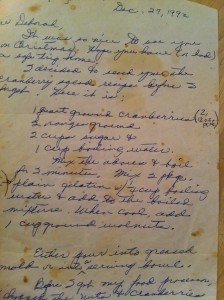I come from Southern pie folk. Pecan, chocolate meringue, lemon meringue, coconut. Pumpkin. Chess. Apple. Cherry. When I see my family this week I will be making a chocolate meringue pie. That was a specialty of my paternal grandmother, who always had one waiting when my dad visited – or she’d whip one up on the spot once he arrived. I’m in charge of keeping my dad in chocolate meringue now. 
But he requests other things, too. He likes the way I do mashed potatoes. Skins on, lumps of butter, plenty of salt and pepper. He’ll even have a generous helping of my vegetable-nut roast, my go-to vegetarian feast day main course.
And he asks for cranberries. These cranberries were a late addition to our family feasts but they are as anticipated and expected now as the longstanding pies.
The cranberries came by way of South Dakota. My maternal grandfather married a woman many years after my grandmother’s death, when I was a young teenager. She came from Scandinavian Midwestern stock and she brought with her to our family’s Virginia tables Norwegian Krumkaka and the cranberries. Before this, I thought canned gelatinous, ridges-still-imprinted cranberry “sauce” was normal. I always loved cranberries, the tartness and the pucker. I was entertained by the comic wiggle from the can onto the serving dish. But I didn’t know what else cranberries could be.
The first time I had Sylvia’s cranberries, the world became wider. When everyone else went back late in the day for an extra piece of pie, I would choose a bowl of her cranberries instead. She used real cranberries, oranges, and walnuts, chopped but still recognizable and formed into a decorative mold. For many years, I eagerly anticipated this new staple of our Thanksgiving and Christmas meals. I’m sure I complimented the cranberries each and every time – probably each and every serving.
One year in early January following a Christmas visit, I received a note in the mail from Sylvia, offering me her cranberry recipe. I don’t know why she decided to give it to me that year. I don’t remember if I ever asked for it. Our relationship with her always bore the markers of a tense politeness, as it seemed to us that though she loved my grandfather, she wasn’t ever really sure about the rest of us.
So it was a little surprising to receive the recipe. And strange to think something so universally beloved and expected on our feast tables came from my step-grandmother. But it’s our recipe now, too, given and received with her blessing, made (mostly) according to her instructions, which I still read in her handwriting on a worn and yellowed piece of stationary.
Virginia pecan pie meets Dakotan cranberries. Strangers become family. The table is wide enough for us all. Happy Thanksgiving!
Sylvia’s Cranberries
Sylvia called this “cranberry salad.” One taste has convinced former cranberry-haters that they do, indeed, like them. We make this at Thanksgiving and Christmas and look forward to it the rest of the year. Enjoy!
2, 12 oz. packages of fresh cranberries, ground
2 oranges, ground
2 cups sugar (I sometimes use less – adjust to your desired sweetness or tartness.)
1 cup boiling water
1 cup walnuts, ground
Optional: 2 packages plain gelatin mixed with ¼ cup boiling water. I used to substitute agar (a vegetarian alternative to gelatin) but realized a couple of years ago it doesn’t really need the gelling agent. I usually pour this into a serving bowl to chill. If you are using a decorative mold and will be flipping it out later onto a plate, you may want the gelling agent.
Rinse cranberries and discard any that are mushy or bad. Chop them into a small-medium dice in the food processor. Dump them into a pot.
Remove orange rind, seeds, and thick pith then pulverize the oranges in the food processor. Add them to the pot with the cranberries.
Add the sugar and the water and mix well. Boil for 2 minutes then remove from heat. When cool, add the ground walnuts. Pour into either a greased mold or a serving bowl and refrigerate overnight or for at least 3-4 hours.
This is a breeze with a food processor but I have also made it several times, chopping it all by hand. It’s worth it either way.

